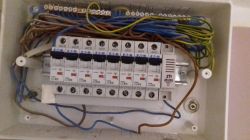JohhnyCage11 wrote:
In this photo you can see various interesting bugs:
- the switchgear has no main switch - the power supply is supplied to the comb that is connected to the lower connectors of the apparatus
- the presence of the Żo conductors (protective conductor, this is the yellow-green one) indicates that the installation is three-core - but the question of what is the entire protective rail connected to - it cannot be seen in the photo - correctly, depending on the type of power supply network (TN, TT) this rail should be properly handled
- eeee - regarding the above point - because I did not get a little sleep today - there are wires in the switchgear, but there are no cables in this example socket - this is a question what the masters have done with them - it is not sometimes that the fuse box was in another place and they moved it by adding pieces of 3-wire cables? if you can see something in the switchgear, it should of course also be in the socket - and it is not there
- lack of a residual current device required by law (Regulation)
- too large denominations - B20 - there cannot be a socket on the perimeter behind such a device, because the socket has a strength of 16A, and besides, there cannot be a 2.5mm? cable, and probably it is - also the question is why as many as 3 such devices
- similarly, if you have any lighting with switches, it is also too large a value, because most household switches have a strength of 10A
- plus the fact that I counted 8 blue wires on the neutral bus, and there are also 8 overcurrent switches, there is also a separate switch for each circuit
- the supply of cables in the switchgear is too large left
- I wonder if the bell is secured




